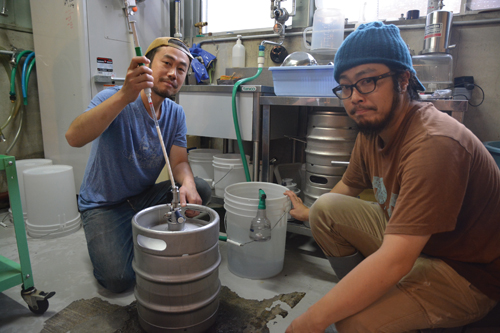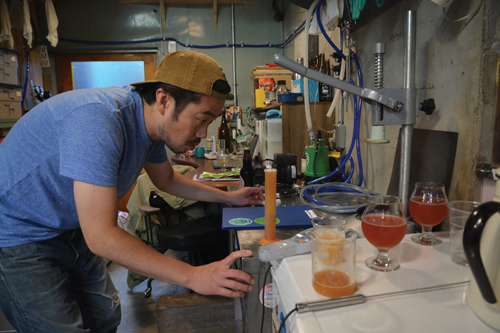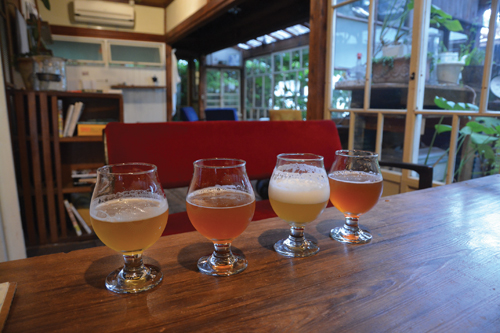
Kanagawa prefecture is home to thirteen craft breweries, ranking it second behind geographically vast Hokkaido. In what we may appropriately call the Craft Beer Prefecture of Kanagawa, in the coastal town of Zushi, the region’s newest craft brewery opened in September, 2012: Yorocco Beer.
Brewer-owner Kichise Akio ran a bar in Enoshima for eight years in the aughts. When he quit, he realized, “In my next job I want something I can do for the rest of my life. I want to be an artisan who makes things.” Right around that time, an older friend with a penchant for craft beer took him to Baird Brewing’s original taproom in Numazu. It was only then that he discovered there was an array of beer styles and that craft beer could be quite good. “I just sort of decided then I would start making the rounds of breweries.”
He set out in Morioka in the northeast and traveled southwest toward Okayama, dropping in on roughly thirty breweries. He had been hoping to get some work as a brewer, but no opportunities arose. Right now craft beer consumption is on the rise and such employment opportunities seem to be posted all around, but several years ago there was no shortage of workers and little need for him.
He had tasted the allure of craft beer, but in being unable to make it himself, it was like an unrequited love. As the spring shifted into summer and he made his way home from his journey, he heard about a part-time job at Yokohama Beer. On applying, he got the gig. It was two months of mostly odd jobs like putting labels on special bottles for summer gifts and delivering kegs.
“I didn’t get to work as a brewer, but I at least got to know the inner workings of the brewery. That experience continues to be instructive and I’m very thankful for having met the head brewer at the time, Suzuki Shinya (who now runs Bay Brewing Yokohama).”
After his two-month stint ended, Kichise studied beer making and worked a job unrelated to beer to save money for capital. He collected as much literature on the topic as he could from the U.S. and consequently realized that he could start a brewery on a much smaller scale than he had originally assumed. Making use of pockets of time, he visited Baird, Isekadoya, Baeren, Iwatekura, Minoh Beer, Zakkokukobo Brewery and others to gather advice on opening a brewery. He cites Tochigi Microbrewery in particular as a place that gave him extremely insightful knowledge on actually applying for a brewing license.
In 2011, after three years of this groundwork and some initial preparations for the brewery, he went to Portland, Oregon for a three-month stay. In that city, craft beer is not something out of the ordinary; it’s a regular part of life. He was impressed similarly to when he first drank Baird Beer and decided then and there that he was going to brew American styles. Shortly after heading back to Japan, he began looking for a building to house his brewery. Unable to find anything suitable in his hometown of Kamakura, he extended his search to nearby Zushi and found something: an old konyaku factory (or “konjac” jelly sweets).
“It already had a sewage system and a boiler so I thought it was perfect. There was still some coagulant for the konyaku stuck to the floor, but I decided I would clean it up myself without spending any more money. A week later, it was gone.”
He signed the lease in December, 2011, applied for his license the following February and got the green light in September. In January, in the midst of this typical preparatory process, he and his wife had a son. It’s a precious time for any new family, but he notes, “I had been talking about opening a brewery for years so my wife was behind me.”
The brewery is just a ten-minute stroll from JR Zushi Station and shares the building with a bakery from Kamakura.
Explains Kichise, “It’s a good building but just too big for what I needed. My friend was a baker and just happened to be looking for some space, too, so we went in together. As you know, bread and beer both use yeast so we had some common ground. I thought that business would be a good fit with our brewery.” The facility is thus called “B&B”, short for “bakery and brewery.”
Yorocco Beer began offering its brews in November, 2012. Kichise laughs as he explains that the name of the brand derives from yorokobi no beer, or “beer to make you happy.” He elaborates, “I wanted it to be beer that increases your enjoyment, consoles you when you are sad and relaxes you when times are tough.” Following that creed, he adopted the slogan, “Your Local Beer.”
Since his launch, his line-up has included a pale ale, a wheat ale, an IPA and a porter. The label designs are all the same, but are distinguished by their colors: yellow, blue, green and B&W.
“I thought people would remember it more easily if they could get their preferred style by color rather than name.”
It’s kind of how Belgium’s Chimay does it with its labels. Like many craft breweries working on the same comparatively small scale, Yorocco Beer opted out of being a brewpub.
“We’re far enough away from the commercial street that few people pass by and, to be honest, running restaurant space is tough work. All that aside, I really just want to concentrate on making beer.”
As an alternative, Yorocco Beer began offering its bottles at nearby eateries. It gradually established itself in central Zushi and, after a year, partnered with a local café called Beach Muffin that asked the brewery to run a taproom there on the weekends. There was an area inside with a dedicated beer server and Kichise could serve the beers himself. Kichise, who wanted feedback directly from the customers drinking his beers, jumped at the offer. The pop-up taproom kicked off on weekends last December.
When I visited, the taproom had four selections, including their standard wheat ale at 4.4% abv. It was definitely a thirst quencher that tended more toward light and refreshing than full-flavored. It exhibited slight acidity and a fruity aroma with mild hop bitterness in a complex balance reminiscent of Belgian styles. He used wheat harvested from the nearby Miura peninsula. The pale ale on tap was a special version using Belgian yeast, lending it fruity aroma that, together with the Amarillo hop, produced a pleasing bouquet—it was easy to drink and tasted just right. The limited edition smoked-apple ale used a blend of ale and weizen yeast together with smoked malt and apple concentrate for a true original. Beyond the swirling fruit and smoke aromas, it presented a spiciness that put me in the mood for some meat cuisine. Yorocoo’s IPA features mango-like aroma from the hop, with pronounced sweetness and spice—this brew, too, shows Belgian-like complexity in its balance of contrasting flavors.
Yorocco Beer is, as noted earlier, American-style but with some Belgian character stemming in part from secondary fermentation. After transferring the fermented beer to conditioning tanks, Kichise adds yeast and sugars again to induce another round of fermentation and achieve his desired carbonation. Most breweries in Japan stop with the primary fermentation and simply add CO2 later. Secondary fermentation generally gives beer more rounded flavor, but adds another layer of difficulty to the brewing.
Kichise admits, “I don’t have the equipment to add CO2, but I planned on using secondary fermentation anyway because I thought it would give my beer a more natural head.”
In response to what he stresses as a brewer, Kichise responds, “I think beer tastes better the more you give it hands-on care.” For him, each step of the process requires his full attention. He enjoys his work while not making it too burdensome, and also budgets enough time to spend with his family.
A certain freedom of expression has developed in Kichise’s beers since he took the opportunity to serve directly to his fans. This summer, which is perhaps Zushi’s most splendid season, definitely drop into the taproom—grab an easy sip of these brews that are laying down local roots with flavors somehow already familiar.
by Kumagai Jinya


This article was published in Japan Beer Times # () and is among the limited content available online. Order your copy through our online shop or download the digital version from the iTunes store to access the full contents of this issue.



